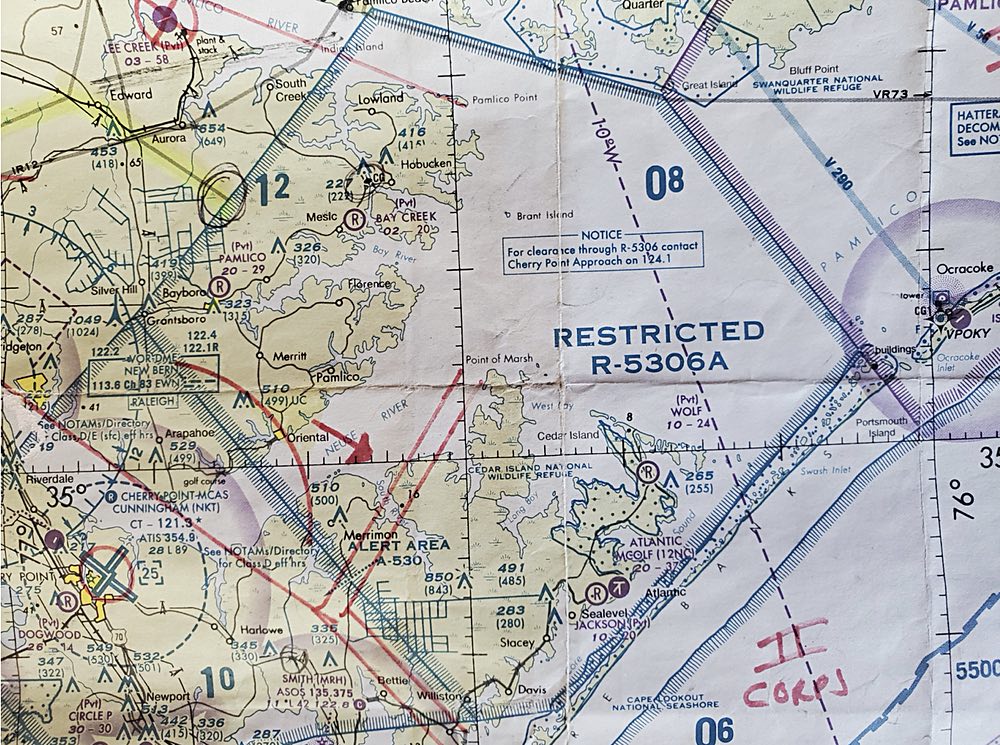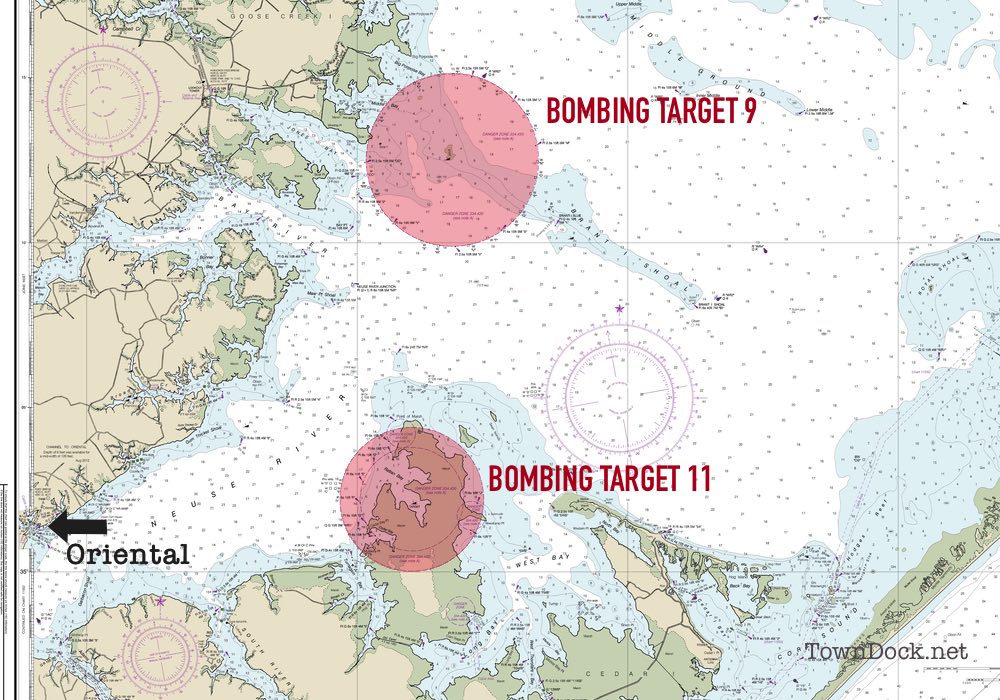It's Saturday November 1, 2025

February 6, 2020
Captain John Rahm of Oriental was once Colonel John Rahm of the USMC. He was also the pilot who landed a Harrier on the National Mall. He writes in to TownDock.net to discuss the busy skies over Oriental.
Our quaint sailing/fishing village lies underneath one of the premiere military training areas in the world. Unbeknownst to us, military aviators are overhead, training for the next conflict by practicing their craft. This training airspace is labeled R5306A. “R” means restricted area. The boundaries of this area run from Bayboro, northeast past Lowland, across the Pamlico River to Pamlico Beach, then east to Ocracoke. The airspace then runs southwest inside the outer banks down to Williston/Davis. The western border runs from Williston over Adams Creek, across the Neuse River, back to Bayboro.The R5306A vertical borders run from the surface – yes the surface of your Oriental property – to 18,000 feet. Surprisingly, you don’t own the air over your front lawn. That airspace belongs to the military. More exactly, the airspace is owned by the government and managed by the military. This area is mostly square with Oriental just inside the western boundary.
Capt. John Rahm’s well used chart. ‘Please disregard the red markups,’ he says.Entry into this airspace is tightly controlled by the Marine Corps Air Station Cherry Point in Havelock. In order to use this airspace, military aviators must schedule its use, usually in one hour blocks of flight time.
Multiple flights can be scheduled into the area at the same time. It is not scheduled “exclusive use”. The area has a common radio frequency (UHF) that all the aircraft monitor. When transiting this area, aviators will announce arrival and departure over the common radio frequency.
Informal de-confliction also happens on this common frequency. Flights will remain over lowlands or open ground farms in order to de-conflict the airspace and avoid a mid-air collision. In addition, the airspace is joint use. Civilians may be allowed to enter or transit, but need permission first. Without permission to enter, civilians are obligated to fly around, outside the boundaries.
Inside the restricted area is the Mid-Atlantic Electronic Warfare Range, MAEWR (pronounced Mawer). The MAEWR is an electronic warfare range that simulates enemy radar emissions. It is a national asset, the details of which are not for public disclosure. Using the MAEWR, aviators fight their way through the various layered enemy defenses on their way to their targets. The MAEWR utilizes the entire restricted area with the training being extremely realistic and therefore valuable. (That’s all I will say about the MAEWR.)
Speaking of simulated training targets, inside the restricted area are the bombing ranges. The primary bombing range is BT-11, located in the center of Piney Island. A secondary bombing range, BT-9, is located east of Hobucken on Brant Island. BT-9 is mostly overflow and usually the second choice for scheduling.
Oriental and the proximity of nearby Bombing Targets 9 & 11.At Piney Island BT-11, there is a simulated airfield, aircraft, tanks and vehicles etc. so aviators can hone their target acquisition skills. Other forces also utilize the bombing range. U.S. Navy SEALS are frequent visitors to the range as they practice integration with aviation operations. We often see their fast boats visit the harbor.
There are no live bombs dropped on any of these ranges. The practice bombs that aviators drop are concrete and steel; they are not filled with explosives and do not explode. Most are fitted with small smoke charges that help locate the impact for scoring. The booms we hear, particularly when the winds are from the east, are the sonic booms from the falling bombs. Thanks to gravity, or the warping of spacetime fabric (it’s that physics thing), the falling bombs break the sound barrier on their way “downhill” to the intended target.
Sometimes you may even hear machine gun fire. This is mostly from Cobra attack helicopters. U.S. forces have a technological advantage at night. So, our forces train like they fight – with a large portion of training at night. In Harriers, 40% of my flying was at night.
Aviators, training to use night technology, prefer a bright moon when first learning their systems. When the moon is “up”, we can expect increased activity overhead. Aircraft often drop parachute illumination flares over the BT-11 bombing range. These illumination flares turn night into day and come in two flavors; the visible ones we see and the infrared ones that are invisible without night vision devices.
Recent advances in sensor technology has also allowed aircraft to prosecute their targets from a higher altitude. In the 1980’s and early 1990’s there was a lot of low flying in the area. Minimum altitude for an aviator then was 200 feet with minimum altitude capable runs to 100 feet.
Now, sensor technology has allowed target acquisition from higher altitudes. Aviators still maintain low flying proficiency, but low flying is not a common tactic. Consequently, it has been a quieter in Pamlico County.
It is difficult to overstate the value of this Pamlico airspace. It is imperative that aviators can practice their skills free from the confines of civilian aviation regulations.
The speed limit for all aircraft flying below 10,000 feet is 250 knots (288 MPH). Military flights are permitted to disregard this speed limit once inside the restricted area. When prosecuting a target, speed is life. 480 knots (552 MPH) into the target area is most common. Aircraft cover 8 nautical miles every minute. We would run into a target covering a mile every 7 ½ seconds.
When bombing targets on Piney Island, we would use the Hobucken Bridge as a run in point. From this easily identified initial point, the 12 miles out the Bay River, across the Neuse to the target would take us less than 90 seconds. (In 90 minutes, we could be in Key West Florida).
Smoke from a recently bombarded bombing target (Eifel Kreutz photo)In addition to the higher speeds, civilian air traffic controllers are ill equipped to manage the sudden altitude changes. Using a comfortable 30 degree dive, we would roll onto the target from 18,000 feet, drop the bomb at 6,000 feet and bottom out around 4,000 feet. A dive bombing run would last about 8 seconds. So dedicated airspace is required. Ultimately, my point is higher speeds require large chunks of training airspace. The air above Oriental is extremely valuable.
I have pontificated about attacking targets on the ground… what about fighter combat?
Fighter combat, jets fighting one another, is accomplished out over the ocean. These chunks of training airspace are labeled Warning Areas. They are much like Restricted Areas. Off our coast is the Whiskey (W) 122. The controlling agency for the W-122 is “Giant Killer” and headquartered in Norfolk Virginia.
Giant Killer is part of the Air Defense Identification Zone on the east coast of the United States. The Whiskeys are valuable because the restricted airspace overhead Oriental is too small for fighter combat. In fighter air-to-air combat, aircraft charge at one another, each, well over 600 knots (690 MPH). Closing velocities well over 1200 knots (1380 MPH) requires a lot of maneuvering airspace. Intercepting aircraft often start 100 miles apart with the intercept lasting 4 to 5 minutes. The closure rate during a typical intercept would be a nautical mile every 5 seconds.
I trust this has been insightful, interesting and helpful. What you hear overhead in Pamlico County is the sound of your continued freedom. Enjoy it. In my next installment, I’ll write some specifics about the bombing range. From Oriental, we often see the flares and fires that provoke a lot of speculation on the internet.
Fair Winds,
Colonel John Rahm, USMC (ret.)
And, in the vernacular of other envious naval aviators, “Harrier Puke”
Related Link• Landing A Harrier On The Mall




